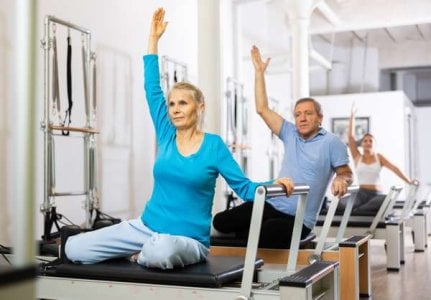Avoid Injury and Stay Strong with These Must-Know Exercise Alternatives for Seniors!
- Replies 3
As we age, our bodies undergo changes that can affect our physical capabilities and risk of injury. For seniors, maintaining strength and fitness is crucial, but it's equally important to adapt exercise routines to suit our changing bodies. The key is to engage in workouts that build strength and flexibility without putting undue stress on joints and muscles that may not be as resilient as they once were.
The original article highlights the importance of considering biological age over chronological age when selecting exercises. Julie Logue, M.P.H., senior program manager for Silver Sneakers, emphasizes that the care we've given our bodies over time can greatly influence the types of movements and intensities that are appropriate for us. This means that two individuals of the same age may have vastly different capabilities and needs when it comes to exercise.
As we enter our 60s and beyond, it's essential to recognize that while we should continue to prioritize strength training, certain exercises may no longer be suitable. Grayson Wickham, D.P.T., a physical therapist and founder of Movement Vault, points out that while physiological changes are inevitable with age, inactivity can exacerbate muscle loss, known as sarcopenia. Therefore, staying active is key, but doing so safely is paramount.

Robert Linkul, C.S.C.S., owner of Training The Older Adult, advises that the exercises we could perform in our younger years may now have a damaging effect on our bodies. It's not about stopping exercise altogether but finding safe and efficient alternatives that provide the benefits without the risks.
Let's explore some common exercises that seniors might consider avoiding and the recommended alternatives that can help you stay strong and injury-free:
1. Inversions: Instead of handstands or inverted sit-ups, which can cause lightheadedness and increase sinus pressure, opt for traditional core and shoulder exercises that keep your head in line with or above your heart.
2. Plyometrics: High-impact movements like box jumps can be tough on the joints. Instead, try medicine ball power moves that develop explosive strength while keeping both feet on the ground.
3. Barbell Back Squat: To avoid compressive force on the spine, choose hex bar or goblet squats, which distribute the load more evenly and are more spine-friendly.
4. Barbell Deadlift: The traditional barbell deadlift can put your back in a vulnerable position. A hex bar, kettlebell, or dumbbell deadlift allows for a more natural grip and body alignment.
5. Barbell Bench Press: Dumbbell chest presses are a safer alternative, allowing for individual joint movement and reducing the risk of shoulder stress.
6. Bent Over Row: Unsupported spinal flexion can lead to back pain. Seated or supported rows are better options for maintaining good posture and targeting the lats without straining the back.
7. Weighted Russian Twist: This exercise can be harsh on the lumbar spine. A Pallof press is a safer core exercise that avoids harmful spinal rotation.
8. Barbell Overhead Press: Dumbbell or kettlebell overhead presses allow for a neutral grip and can be modified to reduce shoulder strain.
9. Walking Lunges: Split squats or stationary lunges reduce the risk of balance-related injuries and can be performed with support if needed.
10. Crunches: Traditional crunches can negatively affect posture. Suitcase carries are an effective core-strengthening alternative that also improves balance and gait.
Remember, the goal is to maintain a healthy and active lifestyle without compromising safety. Always consult with a fitness professional or healthcare provider before starting a new exercise regimen, especially if you have pre-existing health conditions or concerns.
 We'd love to hear from you, our Seniors Discount Club members! Have you found certain exercises to be problematic as you've aged? What modifications or alternatives have you successfully incorporated into your fitness routine? Share your experiences and tips in the comments below, and let's continue to support each other in staying active and strong in our golden years!
We'd love to hear from you, our Seniors Discount Club members! Have you found certain exercises to be problematic as you've aged? What modifications or alternatives have you successfully incorporated into your fitness routine? Share your experiences and tips in the comments below, and let's continue to support each other in staying active and strong in our golden years!
The original article highlights the importance of considering biological age over chronological age when selecting exercises. Julie Logue, M.P.H., senior program manager for Silver Sneakers, emphasizes that the care we've given our bodies over time can greatly influence the types of movements and intensities that are appropriate for us. This means that two individuals of the same age may have vastly different capabilities and needs when it comes to exercise.
As we enter our 60s and beyond, it's essential to recognize that while we should continue to prioritize strength training, certain exercises may no longer be suitable. Grayson Wickham, D.P.T., a physical therapist and founder of Movement Vault, points out that while physiological changes are inevitable with age, inactivity can exacerbate muscle loss, known as sarcopenia. Therefore, staying active is key, but doing so safely is paramount.

Seniors were advised to adjust their workout routines to reduce injury risk and address age-related physiological changes. Credit: Shutterstock
Robert Linkul, C.S.C.S., owner of Training The Older Adult, advises that the exercises we could perform in our younger years may now have a damaging effect on our bodies. It's not about stopping exercise altogether but finding safe and efficient alternatives that provide the benefits without the risks.
Let's explore some common exercises that seniors might consider avoiding and the recommended alternatives that can help you stay strong and injury-free:
1. Inversions: Instead of handstands or inverted sit-ups, which can cause lightheadedness and increase sinus pressure, opt for traditional core and shoulder exercises that keep your head in line with or above your heart.
2. Plyometrics: High-impact movements like box jumps can be tough on the joints. Instead, try medicine ball power moves that develop explosive strength while keeping both feet on the ground.
3. Barbell Back Squat: To avoid compressive force on the spine, choose hex bar or goblet squats, which distribute the load more evenly and are more spine-friendly.
4. Barbell Deadlift: The traditional barbell deadlift can put your back in a vulnerable position. A hex bar, kettlebell, or dumbbell deadlift allows for a more natural grip and body alignment.
5. Barbell Bench Press: Dumbbell chest presses are a safer alternative, allowing for individual joint movement and reducing the risk of shoulder stress.
6. Bent Over Row: Unsupported spinal flexion can lead to back pain. Seated or supported rows are better options for maintaining good posture and targeting the lats without straining the back.
7. Weighted Russian Twist: This exercise can be harsh on the lumbar spine. A Pallof press is a safer core exercise that avoids harmful spinal rotation.
8. Barbell Overhead Press: Dumbbell or kettlebell overhead presses allow for a neutral grip and can be modified to reduce shoulder strain.
9. Walking Lunges: Split squats or stationary lunges reduce the risk of balance-related injuries and can be performed with support if needed.
10. Crunches: Traditional crunches can negatively affect posture. Suitcase carries are an effective core-strengthening alternative that also improves balance and gait.
Remember, the goal is to maintain a healthy and active lifestyle without compromising safety. Always consult with a fitness professional or healthcare provider before starting a new exercise regimen, especially if you have pre-existing health conditions or concerns.
Key Takeaways
- Seniors are advised to adapt their workout routines to minimise injury risk and account for physiological changes that occur with age.
- Certain exercises like inversions, plyometrics, and heavy barbell lifts are deemed less suitable for older adults due to injury risk and stress on joints.
- Expert recommendations suggest swapping risky exercises for safer alternatives like med ball power moves, hex bar squats, supported rows, and suitcase carries to maintain fitness while protecting the body.
- It's important for seniors to prioritise strength training, using modifications that honour their current fitness level, mobility, balance, and overall health.







